Using your home oven properly for baking macarons can help to avoid hollow, lopsided, browned or cracked shells. This post will go over different ways to set your home oven for baking colorful macarons.
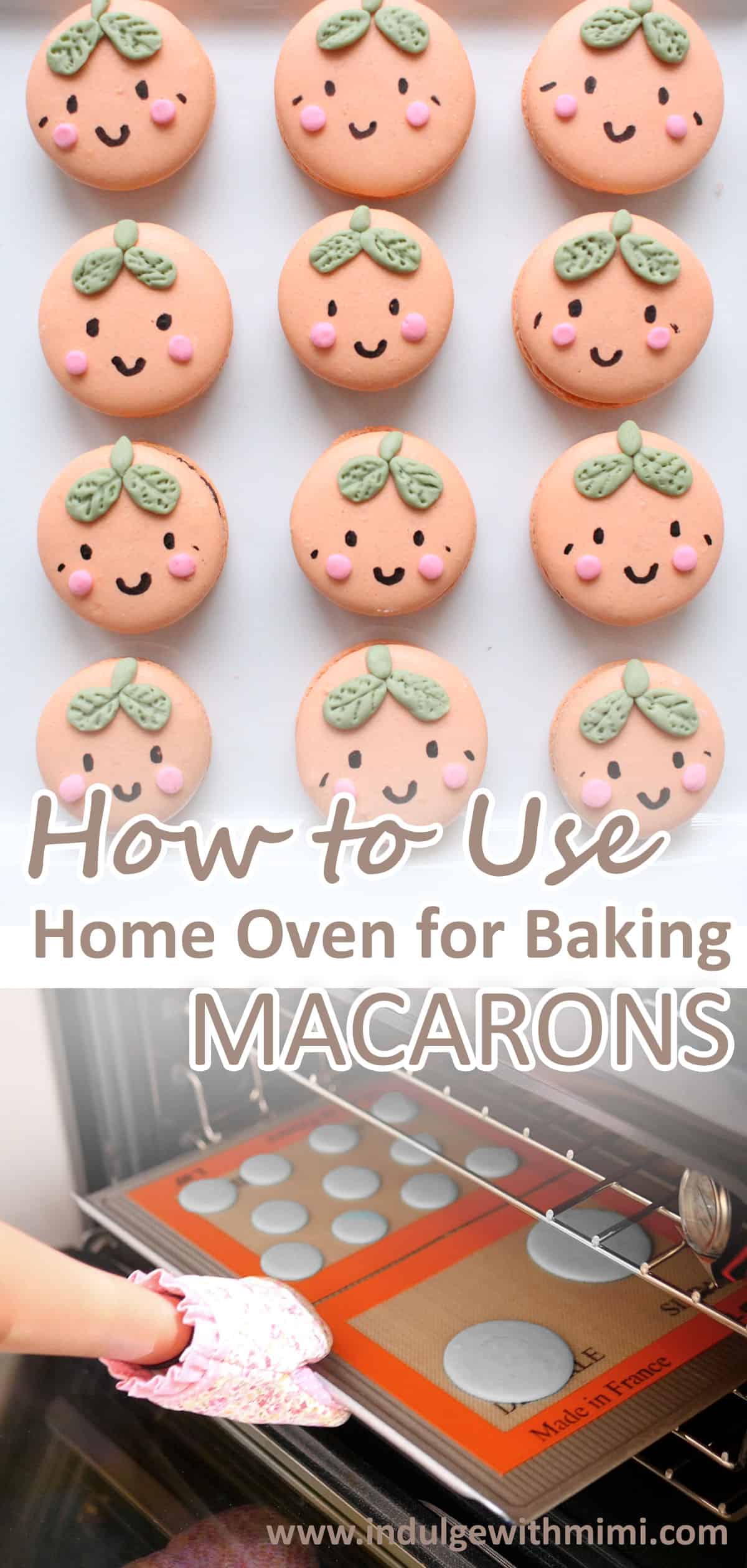
Jump to:
I wrote this post on correctly using your home oven for baking macarons because I found that there wasn't much information about how to use your home oven properly when baking macarons. Unlike spacious and sturdy commercial grade ovens with even heat distribution, home ovens can be temperamental and seem to need a lot of coddling.
For any home baker, it's very important to know their own oven well in order to achieve success with any recipe, even my Best Macaron Recipe will only get you so far in achieving perfect macarons if you don't know how to adjust your oven properly for baking macarons. You will need to experiment under different baking conditions like rack position, temperature and bake time to find the optimal conditions for successful baking. When you learn to trust your oven, it will love you back ♥
When I started making macarons, I was more concerned about feet development and just making sure that the macarons actually looked like macarons. Needless to say, I was not too picky back then. But as I baked more of them, I realized that all the faults like hollow shells, crispy over baked bodies etc. would actually manifest itself in its outer appearance. In other words, you are essentially showing the world all your macaron's faults just by its visual presentation. I started to demand more perfection from these little sweet treats.
Even when you follow a macaron recipe religiously, you can still end up with ugly or underdeveloped macarons simply because you used your oven incorrectly (READ: Macaron Troubleshooting Guide). Almost all the recipes I've come across only instructs to bake at a certain time and temperature on the middle rack. It drove me crazy when I ended up with overly brown or under cooked macarons. It led me to experiment with my oven in order to get my macarons just right.
Average Baking Time & Temperature for Macarons
I'm not claiming to have the exact solution for you because all ovens are different. Every baker should know their own oven well. This post highlights the different ways to adjust your own oven to perfect the baking process. You may need to use a combination of these adjustments to achieve the results you want depending on your own situation.
All of the scenarios below are in reference to the average baking time, temperature and rack position of the two methods below:
♥ FRENCH Method: 320 F for 12-14 minutes on the middle rack ♥
♥ ITALIAN Method: 260 F for 20-22 minutes on the middle rack ♥
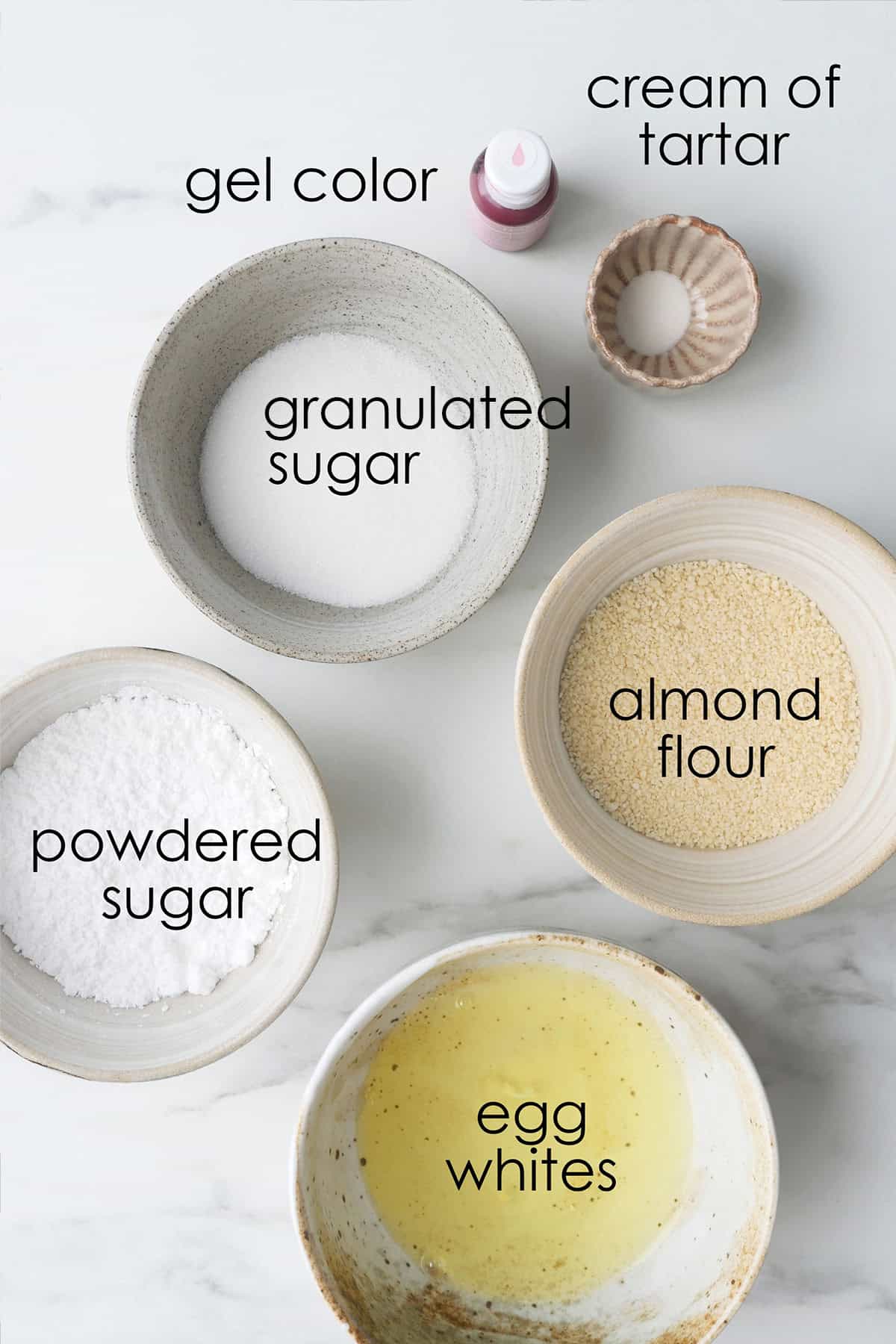

Oven Adjustment Methods
Baking Time and Temperature
Macarons can be over baked/under baked and feet development can be overdeveloped/underdeveloped if the baking time or temperature is not well aligned. For over baked shells or over developed feet, the temperature is probably too high causing it to bake too quickly. You will also find that feet which develop quickly and outwards are also victims of over folding and overly hot oven temperatures. The high heat forces the feet to develop much too quickly and it has nowhere to go except up and out. On the other hand, under baked shells and under developed feet (not a lack of feet due to wrong folding techniques, just underdeveloped), cannot fully reach their full potential when the oven temperature is not high enough.
Learn to adjust the temperatures in your oven. To compensate for adjusted temperatures, you will also need to readjust the baking time and vice versa. For temperature increases, baking time should be decreased. For temperature decreases, baking time should be increased. However, baking at lower temperatures may sometimes result in an undercooked shell and baking at higher temperatures may cause shells to brown. If that is the case, try adjusting the rack position as outlined in the next section.
Baking Time and Temperature Relationship
Macaron Baking Time and Temperature Relationship
↑ Increase temperature - ↓ decrease time
↓ Decrease temperature - ↑ increase time
As a starting point, for every 25 F increase or decrease, compensate with a 2-3 minutes change in baking time in the inverse direction.
Some Recommended Baking Temperature and Times
350 F for 10 minutes - suitable for spacious large ovens
325 F for 12-14 minutes - standard starting point for my recipe
300 F for 16-18 minutes
275 F for 18-20 minutes - suitable for smaller ovens with small compartments
These temperatures are for conventional ovens without convection setting. Usually, it is recommended to decrease the temperature by 25 F when using the convection setting.
Rack Position
The middle rack is often the "default" position in any oven. It's ideal for most foods since it allows the hot air to circulate evenly around the food, resulting in balanced heat distribution. Most recipes recommend that you bake your macarons on the middle shelf. However, you may need to adjust this depending on where your heat source is coming from and your own individual problems.
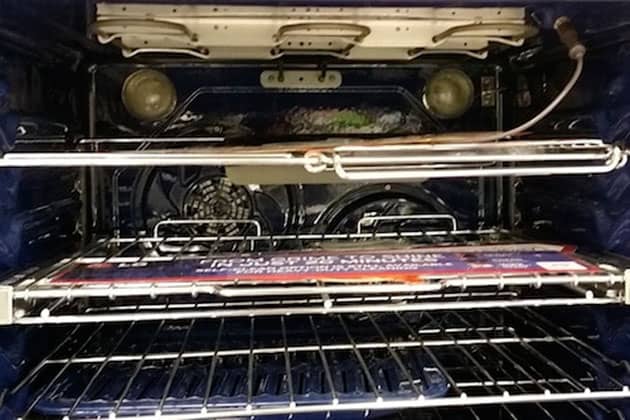
Browning of shell top due to broiler's heat source from the TOP of the oven without convection fan: If the tops of your macarons are browning too fast before the centre is fully cooked, try moving your macarons to a lower rack until the feets develop. Then, place an empty tray on the rack above the shells to shield them from the heat.
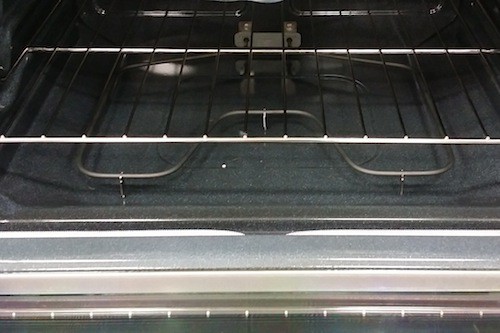
Shells browning on bottom due to heat source from the exposed bake element at the BOTTOM of the oven without convection fan: If your macarons are browning on the bottom before the centre is fully cooked, try moving the macarons to a higher rack. If that alone doesn't help, you can try adding an extra tray immediately below the current tray to prevent it from heating up too quickly.
Convection vs. True Convection
A regular convection oven features a fan which helps to distributes the air around the oven. A "true convection" (a.k.a European convection or third-element convection) utilizes an additional heating element behind the fan to blow heated air to your dish. This method produces more even heat distribution and better baking results.
Using the convection fan
I have become a recent convert to the convection fan since I have found that the temperature remains consistent throughout the baking process with only a 5 degree variance. The fan helps to distribute heat more evenly throughout the oven cavity so you may even be able to bake several trays at once. The heat reaching your macarons may be increased and you may need to decrease the temperature or baking time. As a starting point, it is usually recommended to decrease the temperature by 25 F when using the convection setting.
On the flip side, some bakers may find that their convection fan is a little too strong and causes the macaron shells to become lopsided. You can consider turning on convection cooking during the latter part of the baking period since your shells will already be stronger at that point than when they were wet. If that doesn't help, you may need to skip using the fan altogether.
Having said all that, a convection fan is not necessary when using your home oven for baking macarons. It is a nice added bonus to keep the heat distributing evenly and consistently. You can still achieve this by using other baking tweaks and the proper heat conducting kitchen tools which will be outlined below.
Hot-Preheat Method
If you're still having trouble using a slow and consistent temperature method, try the hot-preheat method. Increase the oven temperature 50 degrees more than the usual baking temperature during the preheat. Once it has reached that temperature and you're ready to bake, turn it down to the regular baking temperature once you place your trays inside. You will need to compensate for this increase in temperature by baking it a shorter amount of time.
This method allows your shells to develop feet from the exposure to the initial high heat but lets them finish off at a lower temperature to avoid browning and over baking. You'll need to be careful of this though as home ovens can cycle hot and cold before it ever reaches your desired temperature so adjusting the temperature mid-way in the baking process may not really change the temperature as you'd hope it would. Read this post on finding a consistent oven temperature.
Reduce Oven Moisture
In Pierre Herme's Macarons book, he advises to open the oven door near the end of the baking time after the feet have developed to let out the steam. Personally, I have never had to do this. I rarely open the oven or turn my trays because I prefer to keep the oven door closed so the heat remains consistent but if this is an area of concern for you, you can also keep the oven door ajar for the whole or for a duration of the baking time by propping a wooden spoon in between the door. You will need to compensate for the loss in heat by increasing the oven temperature.

Good Oven Practices for Baking Macarons
Always Pre-Heat Oven and Use an Oven Thermometer
Always Pre-heat your oven to the correct temperature before placing your trays inside. Place an external oven thermometer inside the oven to ensure that the temperature is correct. Many bakers assume that their ovens are at the correct temperature when in fact, it has increased or decreased during the baking process without their knowledge.
You don't need a fancy thermometer, just a simple hanging one like this one will do. I like that it is small and saves space because it can be hooked on the upper tray. Did you know that the temperature during the initial period of pre-heating is the most unstable? Read my other post on Maintaining a Consistent Oven Temperature.
Identify Hot Spots in Your Oven:
If you are getting uneven results from the same tray of macarons - some are browner than others or some are under baked - you may be facing an issue of hot spots in your oven. You'll need to avoid placing macarons in those areas and rotate your tray throughout the baking time to achieve more even heat distribution.
A great way to identify the hot spots in your oven is to bake several slices of white bread on a tray until it turns brown. You can then see if they have all browned at the same pace or if some are browner than the others.
Bake One Batch at a Time:
I do not recommend baking several trays at once until you have already found the optimal conditions in your oven to bake a perfect batch. Until then, it would be difficult for you to determine why your macarons did not bake successfully. When you bake several batches at once in a small home oven, sometimes heat cannot be evenly distributed to all the shells at the same time. Also, if you are baking on different racks, you would be forcing your macarons to be closer to or further away from a heat source than you'd like. Although not advised for new macaron bakers, if baking several batches at once, try to: alternate the trays midway into the baking time or bake 2 trays on the same rack instead of on different racks. If you have a true convection oven, baking several trays may be easier with the convection setting.
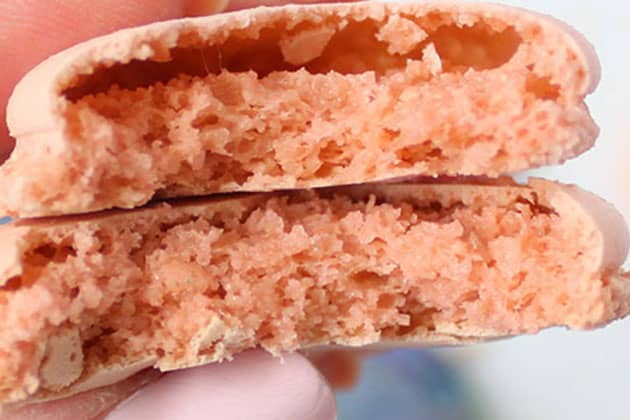
Avoid Hollows
Hollow macaron shells are a result of a combination of poor batter preparation and not enough heat distribution during baking. To combat the latter, use good heat conducting equipment and increase the temperature or baking time.
Check that your baking pan is conducting enough heat to your macaron shells to help it rise. I like using these rimless aluminized steel ones because it conducts heat evenly and allows for good airflow. It is also very sturdy and doesn't buckle easily, preventing lopsided macarons.
A way to encourage heat transfer from the pan to the macarons is to use parchment paper or Teflon sheets instead of silicone mats. I like silicone mats because they keep the macaron shapes from spreading. I only use Silpat branded ones because they are guaranteed to be made from food-grade materials and they conduct heat well.
Lastly, to maintain a consistent temperature inside the oven, try keeping a pizza stone inside the oven on a lower rack from the macarons. I wrote a whole guide on How to Prevent Hollow Macarons if you're interested in reading more about this.
Summary of Macaron Troubleshoots Due to Oven Conditions
(Complete macaron troubleshooting here):
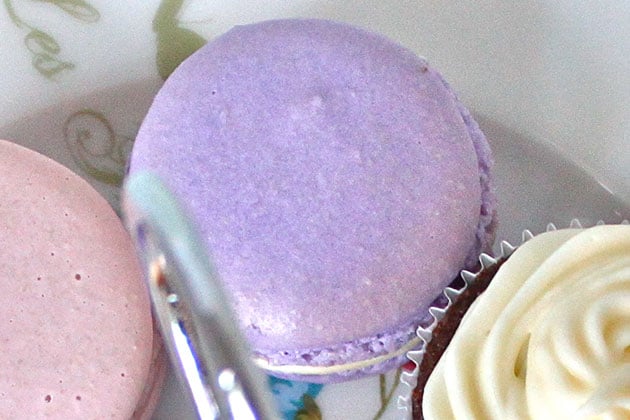
• Shell top is browning:
- move further away from heat source
- decrease temperature, increase time
- shield macarons with empty tray on rack above
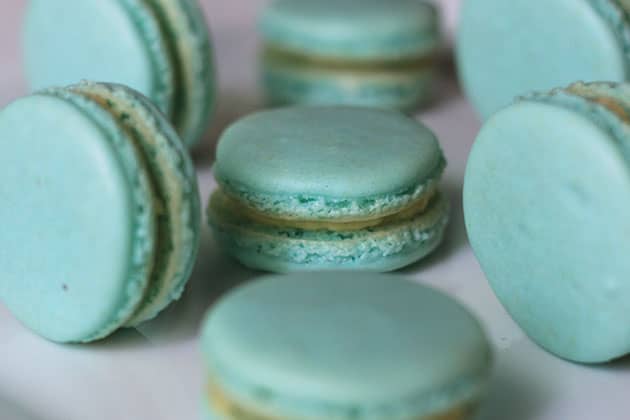
• Shell bottom is browning:
- move further away from heat source
- decrease temperature, increase time
- add double pan on bottom
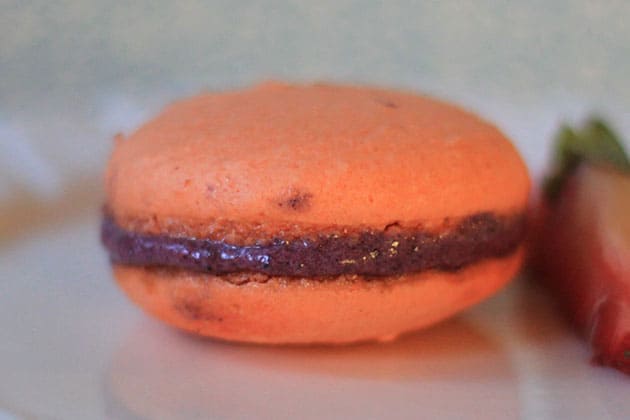
• Shell is undercooked or feet is under-developed:
- move closer to heat source
- increase baking time
- increase temperature
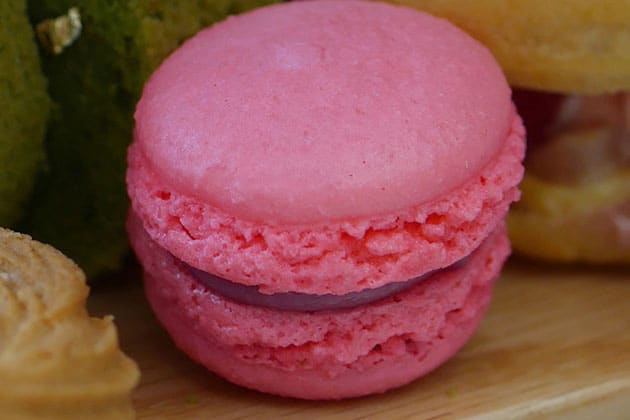
• Shell is overcooked/dry or feet is over-developed:
- let macaron mature 24 hours or more after filling
- brush same flavoured syrup or milk on bottom of shells
- next time, turn down heat or move away from heat source
- stop whipping egg whites once it reaches stiff peaks
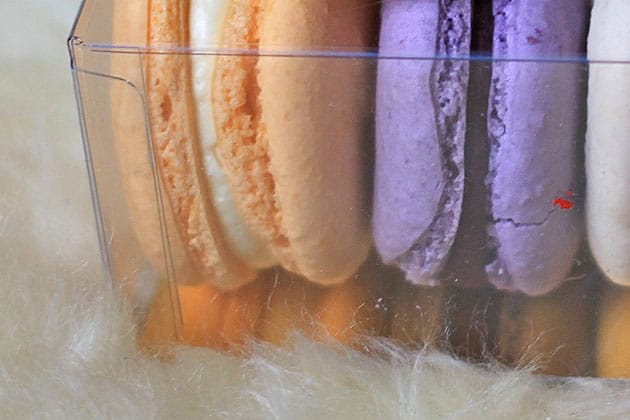
• Shell is lopsided:
- avoid using convection fan if thats the culprit
- avoid using fans the blow directly onto macarons while waiting for skin to develop
-use the range hood fan instead to dry out piped macarons
- consider using a silpat mat instead of parchment paper
- incorrect piping techniques
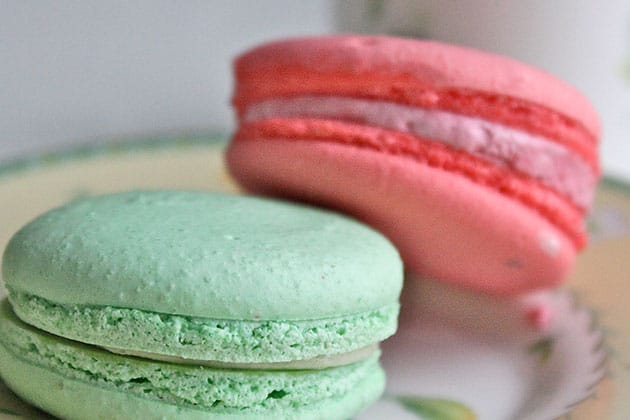
• Inconsistency in the same batch:
- identify hot spots in your oven
- bake only one tray at a time until you find the optimal baking time/temperature
- for trays baked on different racks, alternate the trays midway into the baking time
- ensure batter is fully incorporated before piping
I hope this post on how to correctly use your home oven for baking macarons. Let me know how yours went.
Happy Baking to You!
XOXO, Mimi
Note: This post was originally published on October 1st, 2014.

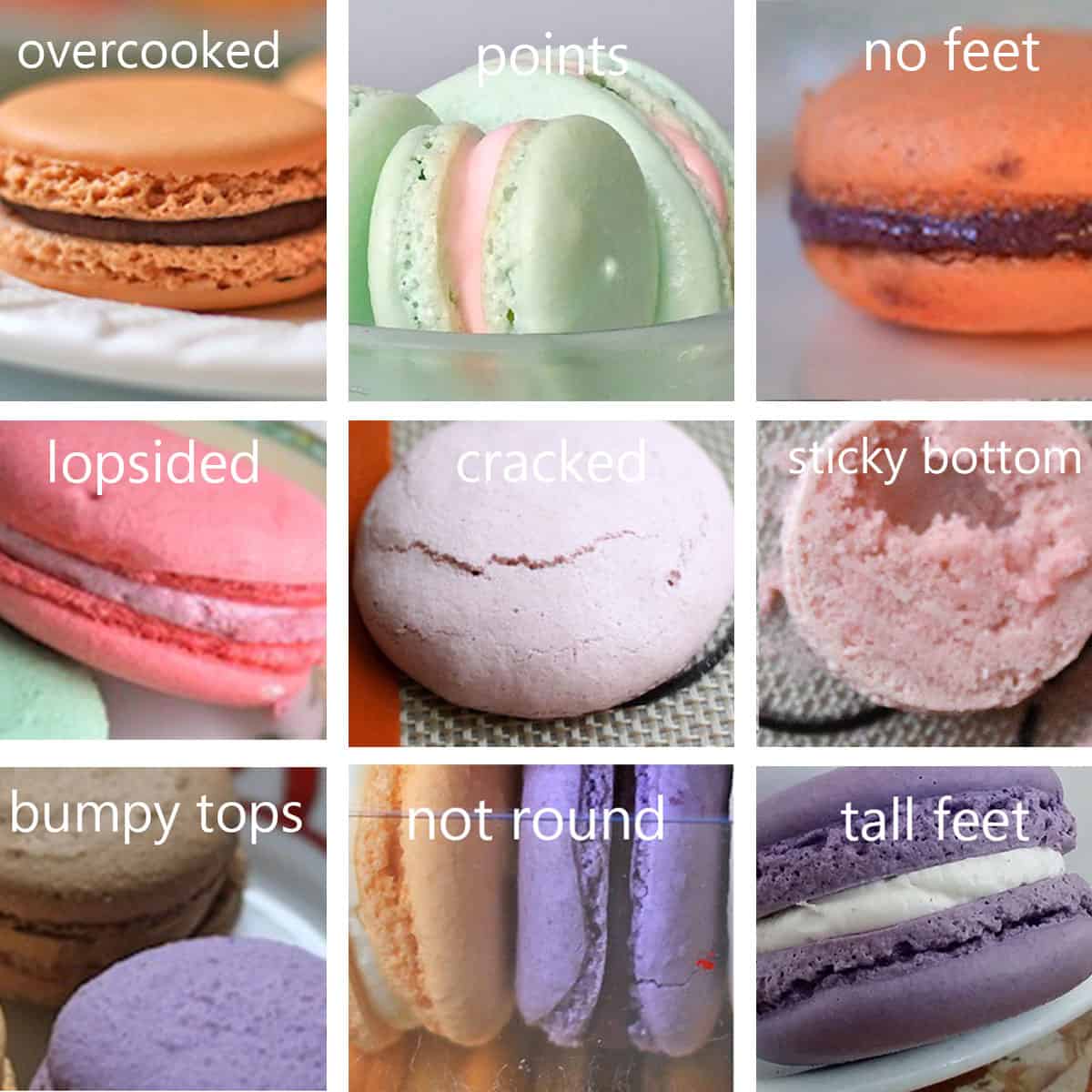
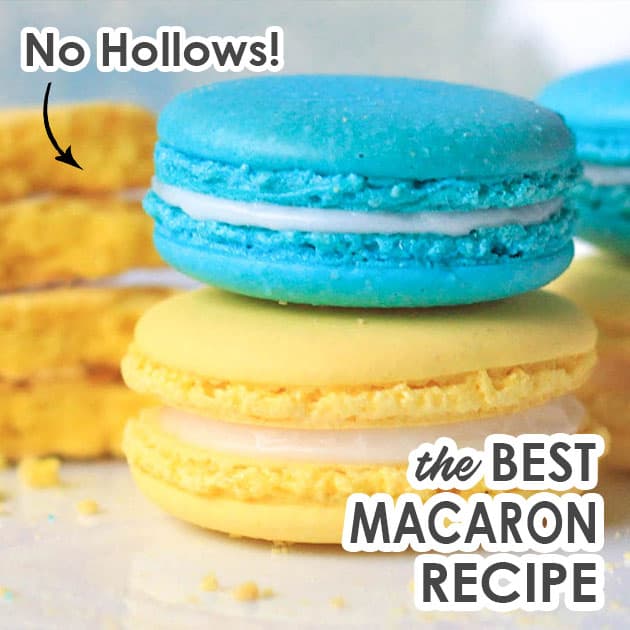
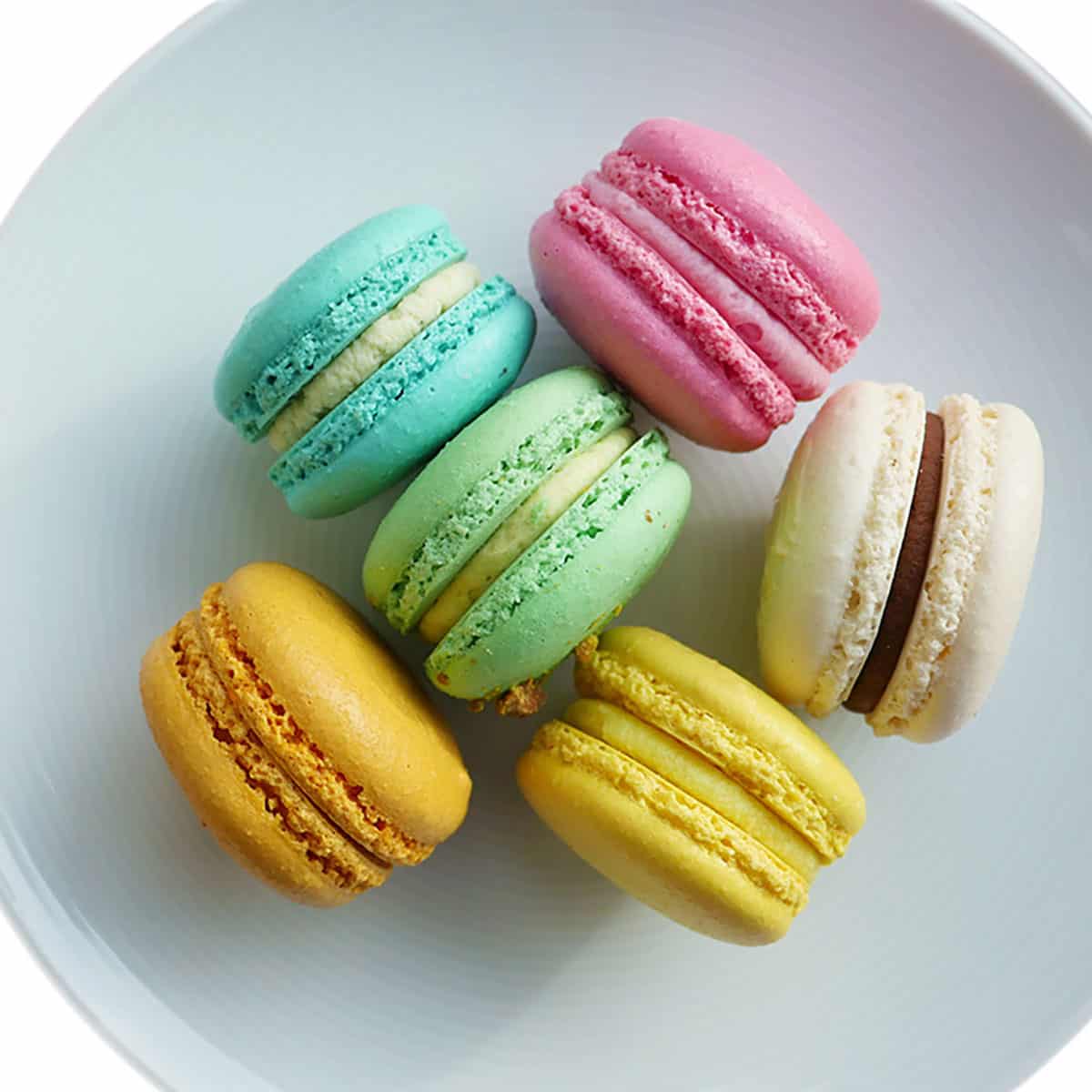
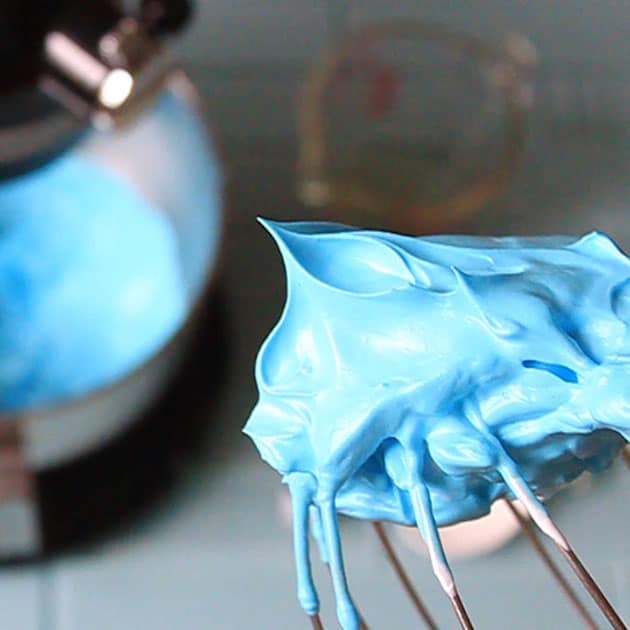
Ninie says
Hello mimi !
I have been using your recipe and try to master it but keep failed ;(
I have few question for u please please reply to me as soon as u have time 🙁 Thank you so much.
1) If the meringue is not stiff peak, you will end up hollow macarons right ?
2) If the meringue is soft peak, you will still end up hollow too ?
3) The higher the temp you will have hollow macarons ?
Mimi says
Hi Ninie,
You will need to get your meringue to just the right stiffness. Not too hard, not too soft. Stop as soon as you reach stiff.
I think macarons tend to be more hollow at lower temperatures than the other way around.
XOXO
Mimi
Connie says
Hi Mimi, first of all, thanks so much for sharing your recipe with us! I tried your macaron recipe and found that if i baked it at the temperature you recommended (320 F for 14 mins) there was no more hollows! However, my macarons started to turn really brown. I read online that sometimes it has to do with using dark baking sheets (mine are black!) so i tried changing my baking sheets to a lighter color, switched down the temp. and increased the time (280 F for 16 mins). I just wanted to ask you, the insides are still a bit moist and sticky, and there's an air pocket on top (http://imgur.com/snsfIhr). Is this considered "hollow"? I'd love to hear any suggestions or thoughts you might have! thanks! xoxo
Mimi says
Hi Connie,
For the photo you sent, I think you're almost there. In fact, most bakers would be thrilled for that result. It's just a small gap between the body and shell. I've seen this a lot at most bakeries Ive been to and there is nothing wrong with it. I wouldn't say its hollow. I know home bakers get a lot of visual cues from social media and lot of #nohollow photos I've posted do show that they fill out to the very top. I'd have to say that it took a long time of playing with my oven to get just the right temperature to prevent browning and a full full shell. Try some more with the oven guide I provided. perhaps you just need to move down your tray a bit from the heat source.
XOXO
Mimi
Ally says
Hi Mimi. I recently went to purchase a convectional gas range thinking that was my solution to avoid hollow macarons. Prior to my new oven, I would reach nice smooth tops and hollow from the inside. Last night, I had 3 batches. 1st/2nd batch were smooth, feet, but hollow. 3rd batch was lifted from the top with a crack. All baked at 300F for 13min. Unless my egg whites are not reaching a nice stiff peak or I am not folding properly, I don't know what else to do. Help me!!!!!
Mimi says
You'll need consistent heat throughout your baking time. I don't think a fancy oven is necessarily required but one with a consistent heat level is important. try cranking up the heat a bit. macaron shells develop better with a higher heat.
XOXO Mimi
Patricia Morria says
I have been trying to perfect macarons for a while now, and I must say, your instructions are fantastic! I have two ovens, one fan, and the other conventional. I tried the fan oven first, with not bad results, and tried the conventional oven today, using your tips for putting a tray above so they don't brown, and they turned out beautiful.
Thank you for your tips!
Mimi says
Wow. Thank you so much for taking the time to let me know how it worked for you! I am so happy to hear that! I hope you'll keep making many more creations like bears and other cute shapes now that you have mastered it 🙂
XOXO,
Mimi
Daniela Gomez says
OMG you've made me see light at the end of the tunnel! I just lost 4 batches of macarons when most of the time I get them right. It's sooooo frustrating! But I'm taking note of all your advice and will try again tomorrow!
I do have a question and it is about the drying stage. I live in Bogota, Colombia and out weather is pretty unpredictable. Sometimes it's warm but sometimes it's pretty cold and rainy. Have you got the chance to test out different drying techniques? Do you find using a fan is better or has humidity ruin your drying stage?
Will appreciate your advice! ❤️
Mimi says
Hi Daniela,
Nice to hear from you and really cool to hear you are writing from all the way in Columbia. As I outlined in my recipe, I like to use a rangehood fan since the air flow won't blow on the shells from a sideway angle causing lopsided macarons. I have not encountered so much humidity before since I live in a climate that is not too humid, although it does rain almost everyday. Pls. see some of the tips I've outlined in the recipe again on how to eliminate humidity in the kitchen before baking.
XOXO
Mimi
Carole says
Hello!
Thank you so much for sharing the recipe.
I am planning on trying the recipe out! I've never done maccaron before.
I would like to ask you. Is it better to try baking the maccaron on baking mat or parchment paper? Would I get the same result?
Do you recommend any mat?
Thanks
Mimi says
Hi Carole,
If you're baking for the first time, I recommend parchment paper. It's much easier for the shells to develop feet. You'll be able to pinpoint areas of concern for you as well as you go along. Once you get the hang of it, then move to silpats. They are excellent for keeping the shapes round and nice 🙂
XOXO,
Mimi
Cecilia says
Hi Mi Mi!
After reading and searching through your blog, I still don't really understand the purpose of oven thermometer and how to use it (I might have misread some information). I mean, what do I do when the oven thermometer reads the temperature of the oven below or above the "moderate" temp to bake macarons? (ex: initially bake at 300F, then the temperature falls to 290F, do I just increase the temperature back to 300F?)
Also, my macarons were a little bit brown on the bottom, I am not sure whether it was because of the heat source or the food coloring that I used. (I baked my macarons at 325F, middle rack, and I used wilton gel food coloring).
Thank you in advance 🙂 <3
ps; I love your blog, instagram and youtube channel :). You are very very talented <3
Mimi says
Thank you Cecilia! That is so sweet of you.
If you find your temperatures are fluctuating, I would not keep adjusting it because it takes a while for home ovens to stabilize in temperature. You should actually try to find out how much time it takes your oven to reach a consistent heat level then put your trays in then. Read this other post I wrote:
https://www.indulgewithmimi.com/lamb-macarons-finding-the-correct-oven-temperature/
As for the brown bottoms, I'm not sure if a colouring can actually CAUSE browning but I have heard from other bakers that Wilton is not as good for baking/heat. I use Americolour and it works for me everytime.
XOXO,
Mimi
Samantha says
By the way, I bake without convection at 300 degrees, 10 minutes, rotate pans and then another 10 minutes. I see your suggestion above is to decrease to 260 degrees for Italian method?
Mimi says
Yes, I prefer to bake my Italians at lower temps at 260 🙂
XOXO,
Mimi
Samantha says
Hello! I LOVE that you've written about controlling home oven temperatures. I am certain my (Italian method) batter is strong, but am having inconsistent results. Because I need to make many many macaron at once, I am baking two trays at a time and I really like your suggestion of baking two at once on the same rack.
My macaron are either browned and hollow OR undercooked, sticking to the parchment paper and not hollow. If I understand your pages properly, I guess the problem for the first is too high heat and the latter is too low heat/not cooked long enough?
This is the most helpful site I have found. Thank you for posting.
Mimi says
There could be many variances with macarons. It could be the batter itself. It really depends if the situation you are describing is actually from the same batter. Test your batter at different temperatures and see what happens.
XOXO,
Mimi
wache says
Hey Mimi, I want to say that your post saved me! I've tried to make this so many times with various methods, and I finally stumbled upon this page and realized - I can't bake my macaron at the middle rack!! Not saying I am making perfect macarons at the moment but let's say the end product is... resembling what a macaron looks like with feet!
Mimi says
Hi! That is sooo sweet of you to leave me a message about your success! I'm so happy for you! Now that you got it down, try some of my #macaronart tutorials too 🙂
XOXO,
Mimi
Samantha @mykitchenlove says
So informative! I'm working up the guts to make some macs and this post was very helpful! My oven is dual heated (electric and gas) do you have much experience with that type of oven? Love all your photos as well.
Mimi says
Sorry for the delay! I took some time out to find out about dual ovens. First of all, lucky you! Second, from my what I've read, it seems that the oven itself is usually electric and the stove top is gas. If that's the case with yours, then I assume you can use my guide Oven Guide as per usual since I think it should behave like a normal electrical oven. Correct me if I'm wrong. Are you having any issues with fluctuating temperatures in yours?
Ninie says
Hello Mimi !
Thanks for writing this great and so detail post ! Everytime I bake macarons they always come out perfect except HOLLOW that drive me crazy. Since you said about the Convection Oven and True Convection oven but my oven doesn't have a fan, so do I still bake at 320F ? Usually I baked at 300F for 10mins. But after read your post I think I have to buy the oven ther. Hopefully you will answer and help me master those Macarons like you 🙂 Thanks
Mimi says
Hi Ninie,
I find that when I turn on the fan, the heat is much more even, consistent and a bit higher than without. What temperature you use will depend on your oven. It really depends what kind of results you are already getting with 320F. Look at the appearance of your macs and go from there. Hollows most likely come from weak meringue, overfolding and low oven heat. Don't worry too much about the convection fan, you can still get great results without. I used to bake without even turning on the fan.
Gabrielle Russell says
I have found that adding 5 grams of powdered egg whites for every 50 grams of fresh egg whites guarantees I will not have hollows. It's a miracle!
Mimi says
I'm glad you found something that works for you 🙂
thanks for sharing
xo
Mimi
Hana says
Thanks for writing this article. What does it mean when my macarons pop like a volcano? I'm guessing it's high heat so I'd lower it but then the macarons shell isn't quite crunchy enough even with lengthened baking time. Any suggestions are greatly appreciated.
Mimi says
Hi Hana,
Can you clarify what you mean about the volcano? Does it crack and the insides spill out of it? If so, you will need to make sure that your batter is not too wet (could be overfolding or unaged egg whites etc...) and remember to tap the tray hard against the counter to release any air bubbles inside the batter.
Olivia @ livforcake says
Another great post! Thank you Mimi! My oven is definitely a culprit and I am starting to hate it. It's a gas oven and a HUGE pain in the butt. I got an oven thermometer for Christmas and have been using it religiously. The temperature can sometimes span a 50 degree difference during ONE baking session, so I need to keep an eye on it at all times.
I think the issues with my last batch were probably too high heat and lopsidedness due to the convection setting which I *thought* would help them cook more evenly. No more convection for me!
indulgewithmimi says
Yes! I also do not use convection for my macs. I get pretty good results without it. It must be much harder to control the temperature in a gas oven. (I'm only guessing from what you're saying). I had been doing a lot of research lately for ovens because I had to buy a new one. It seems the best performing ones will control the temperature more evenly. My mom bakes her small cakes in a small counter-top convection oven. I thought it was pretty ingenious. I'm not sure if it would work for finnicky macs but I guess it might be worth investigating if you're having way too much trouble controlling your gas oven and don't want to replace such a big appliance.
Maryam says
Thank you very much for all very useful information. I've been addicted to making macarons, but every time I make them I have different results ))) I love your site.
indulgewithmimi says
Thank you for leaving me a message! I will be working on more posts soon, maybe some more macaron art and my Macaron Surprise! cake. Let me know how your macaron adventures go! XOXO, Mimi